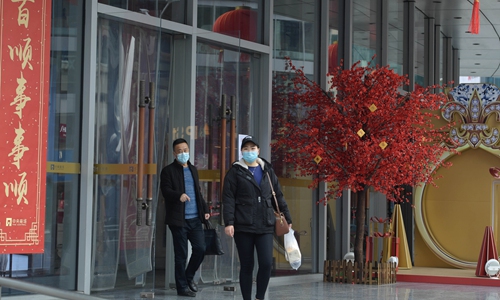COMMENTS / EXPERT ASSESSMENT
Consumption rebound certain but efforts need to increase tenfold

Two customers walk out of a shopping mall in Nanjing, East China's Jiangsu Province on February 19. Photo: cnsphotos
The ongoing novel coronavirus pneumonia (COVID-19) epidemic has had a great impact on China's economy. In these circumstances, in order to accomplish this year's social economic goal and increase income for Chinese people, a strong rebound is needed for the Chinese economy.A rebound is certain, but we need a strong rebound to lay solid foundations for the economy. Therefore, efforts need to increase tenfold.
Shrinking aggregate demand could drag China's consumption down to negative growth in the first quarter due to COVID-19. In first two months of 2020, consumption is expected to drop 17 percent year-on-year in online retail, 60 percent in catering services, 92 percent in box offices, 90 percent in games and performances, and 97 percent in tourism. A total of 1.38 trillion yuan ($200 billion) in consumption is expected to be lost in January and February due to the epidemic.
On the demand side, this year will be tough. Driving up aggregate demand, consumption, investment and exports are crucial.
On the supply side, the coronavirus has influenced more areas than SARS in terms of population, GDP proportion and retails sales. Moreover, the shutdown China has experienced this time around is much more severe than that during SARS.
The main difficulties for resuming operations are the congestion of logistics, labor flows and transportation. In a survey polling near 10,000 firms, 36.9 percent of enterprises said they were concerned about a new virus spread after resuming production.
The overall macroeconomic environment has changed significantly from the time of SARS. International trade growth has also seen its peak. The business cycle and external environment are entirely different under the coronavirus to how they were during SARS.
The global economy and the Chinese economy were rising in 2003. There was very quick economic rebound in 2003 after the government's policy kicked in. However, in today's environment, a quick rebound will be more difficult to achieve.
The upside is that China's 2018-19 investment and manufacturing remained stable. Investment increased 23.7 percent year-on-year in 2018 and 24 percent in 2019. The government in 2018 adopted policies such as tax cuts, investment boosts, macroeconomic policy and monetary policy support to stabilize the manufacturing sector. That set a solid base for the economy to rally.
Meanwhile, technologies such as the internet, cloud services, artificial intelligence and 5G have played a positive role in combating the coronavirus by improving efficiency and creating new ecologies. Online education, medical services, entertainment and offices have all experienced development in leaps and bounds. After the epidemic is over, China is expected to undergo large-scale digitalization and smart technology upgrade, which will have long-term influence on the economy.
To resume operations, the government will need to apply a slew of policies targeting aggregate demand and supply.
For China to achieve its 2020 economic and social growth goals, it needs to hit several key targets.
China must resume operations quickly. It should resume business, logistics, people flows, and financial and policy supports. Operations need to return to their levels prior to the epidemic.
The country should start with key industries and restore industrial chains. That will be complicated by the impact of epidemic, which has affected more than 60 percent of the country. Therefore it is important to focus on recovering the industrial chains of key industries.
China should make full efforts to promote the recovery of trade and exports. February and March are usually the peak times for trade orders, so in this period, exports that promote trade recovery will be particularly important - particularly as the global economy is experiencing sluggish growth.
China must make every effort to boost and encourage post-epidemic consumption. The contribution of consumption to GDP growth has now exceeded 60 percent. It is important to create a consumption climax.
Finally, China should further foster the digitalization of its economy based on scientific and technological innovation emerging in the fight against COVID-19.
The article was compiled based on a speech by Zhu Min, former deputy managing director of the IMF on a forum organized by the PBC School of Finance at Tsinghua University. bizopinion@globaltimes.com.cn
